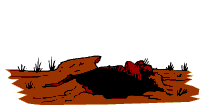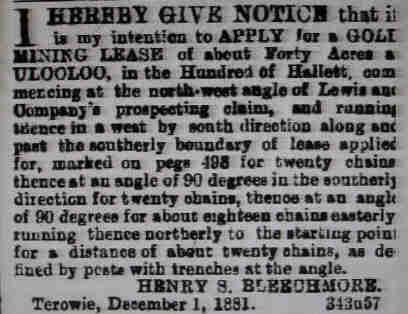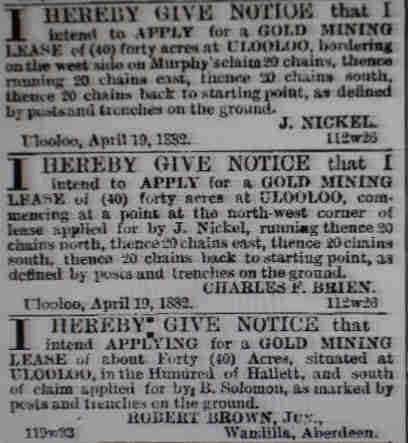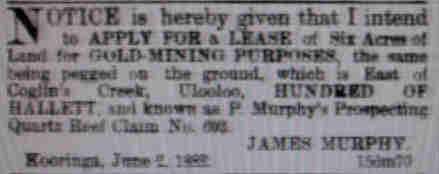


|


The Ulooloo Goldfield.Part 2 In January 1873 the field was almost deserted and only a government prospecting party was actively working the area. Both the storekeeper and publican wandered around fossicking the creeks and bewailing their lonely condition. It was not just the miners; some of the locals, who had been able to supply diggers with basic necessities, also fell on hard times. The Mutton family was still trying, and by patient industry managing to eke out enough to pay for their daily needs. D Mutton, had previously found a very pretty nugget, weighing 27 dwts. and been offered 5 for it, later had a show at Cousins' Gully. When Thomas Fitzgerald found a one-ounce nugget at a depth of seven yards on 11 March, more than 20 men rushed the field again. With other diggers arriving or leaving during the next few months, very few remained for any length of time; only 16 diggers were left by October 1873. A month later, on 1 December, Thomas Stafford also left the field to be admitted to the Adelaide Hospital with a broken knee-cap. The only benefit of all the disillusionment experienced on the Northern Territory goldfields was an increase in prospecting in South Australia. The Guardian was glad to find that there was an increasing probability of good Home diggings being developed. Not only do the prospects of the Lady Alice, Tyeka and Barossa reefs generally promise abundant returns, it said, but the newly discovered reefs of the Onkaparinga district show equally favourable indications. The Kangaroo reef is widening and looking better than ever and a rush is setting in to the adjoining Empress claims. After the discovery of gold at Waukaringa in 1873 and other discoveries during the 1870s, it was once again realised that a much more systematic approach to prospecting and mining had to be made in South Australia if mining, of gold and other minerals, was ever going to provide lasting benefits. One newspaper supported the view that it was time South Australians devoted a little more energy towards developing their gold mines, as they were as rich, if not richer than those of Victoria. As the average rainfall seemed to improve and more land being made available by the government, several people bought farming land in and around Ulooloo. In August 1874 W Brayley bought section 122 of 318 acres in the Hundred of Terowie. J Simmons bought section 670 of 539 acres in the Hundred of Hallett on 4 March 1875 whereas C Simmons bought 169 acres. Finally there was one happy reader who commended the Bunyip newspaper for publishing so many reports on South Australian mines, which plainly showed that they were not run in the Northern Territory style, thereby strengthening the confidence of the shareholders. Presumably there were also other happy people around. On 1 January 1875 Rev JB Stephenson married Ernest Selles of Kooringa and Mary Ann Beckwith, eldest daughter of John Beckwith of Ulooloo. On 18 May 1875, John Bryce, farmer of Ulooloo died at Redruth from inflammation of the lungs. He was only 52 years old. Less than a year later John James Bryce, aged 10 years, died of scarlatina and diphtheria on 4 August 1876. By 1877 there were few diggers left at Ulooloo, and those who were still there had not found too much gold either. Johann Friedrich Carl Schmidt, who died on 4 August 1877, had been living in a tent with his mates W Mahnke and August Pepperkorn for some time. At the later inquest at Hallett on Tuesday, 7 August by Mr JD Gave, J.P., Samuel Temby was elected Foreman of the Jury. Henry Wehr, farmer, residing at McVitty's Flat stated 'I met deceased about six week's ago at Jamestown. There were five men together in a party. They stopped at my place for the night. Saw deceased again about a fortnight afterwards. He said two of his mates had left. Last Sunday fortnight deceased came to my house and slept there that night. He complained of shortness of wind and of pain in the chest. He was spitting blood several times that day. Saw him again at his tent at Ulooloo on August 1. He did not complain then. Last Saturday went to cart deceased's and Mahnke's washing-stuff to the creek. Deceased then appeared very weak and only shovelled the dirt into the buckets. Left him at work, and did not see him again alive'. Saw him on Monday in the tent dead, and helped to bring him to Hallett in the afternoon. Deceased appeared to be used to drink, and as though he could not stand much work. W Mahnke, gold digger, residing at Ulooloo, said 'Deceased had been a mate of mine for seven weeks. He had been able to work all the time to the last hour. He had a cold and complained of rheumatism in his legs, and his breath was very short. He had been spitting blood many times. He worked on Saturday, August 4, until 5 p.m'. August Pepperkorn, also a gold digger residing at Ulooloo deposed, 'I knew deceased, who had been my mate for about six weeks. Was working with deceased on Saturday last up to a little before sundown. We went home then and had supper together in the tent. Deceased had bread and butter and tea. Talked together and smoked by the fire until about 9 o'clock, when we went to bed. About 10 minutes afterwards Schmidt got unwell, and got out of bed. He asked me to fetch some water. He drank some, and then walked about outside. He got worse and worse, and I made him some tea. He got worse still, and could not drink the tea. He said he thought he should die. I took him in my arms, and deceased tried to give me an address to write, but he was unable and died in my arms'. The Jury returned the verdict 'That the deceased died from natural causes'. Excessive consumption of alcohol was a problem on all the goldfields. The South Australian Total Abstinence League and Band of Hope Union were also established at Ulooloo. They worked hard to get the men off the drink by holding regular meetings. By the middle of 1876 they had 58 members on the books and a total of 72 abstainers. A year later the numbers were 50 and 70 but by 1878 both had declined to 35 and 55 respectively. Some reasons for the sharp decline could have been fewer diggers and a more settled population, which included many farmers. None of the few diggers still left on the field had been able to make tucker. Although the successes and failures of so many gold mines in both the Northern Territory and South Australia had made headlines for some years, the need for a Geological Survey had not been forgotten. On 30 January 1877, the Adelaide Philosophical Society passed a motion, proposed by Professor Ralph Tate, calling for an official geological survey. With very few new gold or other mineral discoveries during the latter part of the 1870s, and an increase in the general level of unemployment in South Australia, several concerned diggers wrote to the editors of city and country newspapers giving their thoughts on what should be done to alleviate some of the problems. All of them saw gold mining as a panacea for all economic problems. Old North wrote, Now that the Colony seems on the point of being flooded with labour I think the government could not go far wrong if at present they would encourage the development of the colonial goldfields. If they should feel so inclined, I am willing to point out to them two or three places where I have prospected and found gold, but had to leave on account of the drought. Though total gold production in South Australia in 1879 was less than half of what some diggers had found individually in one day during better times, enough encouraging reports circulated for the nearby town of Hallett to finance a small party of men to give the Ulooloo goldfield another try. No sooner had they arrived on the field than a start was made sinking for a reef. They went as far down as 10 feet but were prepared to go 100 feet hoping to cut the reef and find enough wash, or pay dirt to cover their expenses and efforts. After short lived excitement, which broke the peace and quiet of the field, the Hallett party returned home empty handed. With a government experienced in passing motions, but failing to act on them and a continuation of the drought, more and more people voiced their opinion and tendered advice. William J Thompson was convinced that more attention should be given to the northeast of South Australia where there was a second Ballarat and millions of pounds worth of gold. Nothing was found but life had to go on, gold or no gold. On 10 March 1880 James Martin and Annie Hyde, both of McVittie's Flat were married at the Wesleyan Church. On 12 December an anniversary service was held at the Ulooloo Wesleyan Church by the Rev. J Bickford of Burra. A few months later Thomas Wall and Ellen Henderson were married and in July 1881 John Bradley, JP attended a farewell dinner at Burra for Henry Dawson JP who was leaving the district. On 22 June 1882 George Wall of Hampton married Jessie Bryce of Ulooloo. In November 1880, Advance wrote In the face of a probable bad harvest and consequent general depression, with scarcity of work and money, would it not be wise to give some practical attention to the matter of gold mining in this colony? There is a general impression that rich deposits of gold exist in the hills region east of Adelaide and that what is wanted is a series of really adequate tests. The government might expend a few thousands of Pounds in maintaining a few parties of good practical miners. A few months later it was John Richards who accused the government of not doing enough. Although it had now bought a diamond drill in America, it had not been used yet in the search for gold or even base metals, which if discovered, would support ever so many people. Another disgruntled writer wanted to know why in these exceedingly dull times, which would get worse as a result of the last harvest, the known valuable mineral deposits, especially the gold producing districts, of this colony were not worked? The editor of the Register too said that the government should do something. He pointed out that there still had not been a systematic geological survey made of South Australia. William Lawes Ware stated that during 1880 the gold mining industry of Victoria had paid out more dividends than all other companies together, including banks, gas and insurance companies. He wondered if it really could be true that a mere boundary line on a map had cut off South Australia from participating in these good things. Not everyone agreed that the government should do everything or anything at all as far as gold mining was concerned. Kenneth G Lomax from Farina was convinced that the large reward for the discovery of a goldfield should be enough. John Baptist Austin didnt think so either and did something about it. In March he convened a meeting at the Prince Alfred Hotel of about 50 people interested in developing South Australias gold deposits. It resulted in the formation of the South Australian Gold Mining Association. Soon after, it was reported that a party of prospectors from Clare had left for Ulooloo with the intention of thoroughly prospecting the field. There was no doubt that if this were done properly a payable goldfield would be discovered. A few weeks later, a number of politicians, including the Minister of Education, floated the Diamond Drill Company. It would import one or more diamond drills, with all the necessary appliances, for the development of South Australias resources. After some new discoveries on old fields and new fields in New South Wales and Queensland, public perception about the role of government in relation to the promotion of gold mining changed rapidly. Increasingly, a revival of gold mining and gold mining speculation became apparent.
One of the many hopefuls Once more new gold mining companies were floated almost weekly, most of them heavily promoted by politicians, for their own benefits naturally! Before long, hopes were expressed that South Australia had taken a lesson from the Victorians and would avoid overestimating the value of its reefs. By the end of 1881 warnings had also been sounded and become much more specific, pointing out the dangers of uncontrolled speculation. Once again people were reminded of the earlier Northern Territory scandals. They were warned about the absurdly high brokerage fees, which were out of all proportions in relation to the capital raised by the latest floats. They were also warned again and again about the shadowy information given in prospectuses such as There is known to be a reef half a mile or a mile away, which it is thought contains gold and it is confidently believed this reef passes through the property. Upon statements like this, plus the names of a few politicians, investors were expected, and did, invest 10,000 or even 40,000.
Regardless of several good gold discoveries across the South Australian border, creating new hope, excitement and work for South Australian engineering firms and individuals, there were still enough locals who believed that South Australian goldfields, and Ulooloo in particular, were the answer to all economic problems and an assured road to financial independence, especially after Charles Boult found a six ounce nugget. Gold was soon displayed at Hugo Fischer's shop in Grenfell Street Adelaide. Early in 1882 Patrick Murphy tried to float Patrick Murphys Gold Mining Company. Being an optimist, Murphy was convinced that he had the flow or boil with gold-bearing stone that will lead down to the reef. When that reef is struck, he said, it will make Ulooloo the best gold producing field in South Australia. He wasnt the only optimist either, as a few months later the Ulooloo Gold Mining Company was floated with a proposed capital of 40,000. It wanted to buy gold claim 498 near Coglins Creek, owned by John Atkinson. He would be paid 500 in cash and 10,000 half paid up 1 shares. The promoters would receive 1,000 shares each. The prospectus contained a report by mining surveyor Jonathan Seaver. He stated that anyone with a comparatively fair knowledge of mining could see for himself the genuineness of mining on this property and the good prospects it holds out of being a valuable investment. This was too much for Patrick and it only took him a few days to have his opinion published in the Burra Record of Friday 10 March 1882. The Editor made it clear though that he did not hold himself responsible for the opinions expressed. Even though the letter was out of place in this column he would for once waive the point. To the Editor of the Burra Record. Dear Sir, If you will be kind enough to insert the following few words for the information of enquirers or intended shareholders you will greatly oblige as a great many have been wanting to know how it is that a hundred shares at 5 each can pay a working capital to the amount of 1500 each upon ten promoters shares. In explanation I tell them that under the No Liability Act there is no necessity for any amount whatever to be placed upon the allotted shares. The shares are sold at whatever price they may think proper to put upon them, the meeting held and a call made, aud the work carried on, if necessary another call, and so forth as long as the shareholders think proper. When any shareholder feels indisposed to pay further calls he has only to give notice that he has given np his interest, when some party having more confidence in the venture may take them up, and so the thing goes on.
A great many have been asking these questions who could explain them better than I can, but it is merely to throw a doubt where none exists. You see, Mr Editor, I have got no Hon. Mr This or Right Hon. Mr That to my prospectus to gull the public, and why? because they can get no interest for nothing in it, but I have got the claim, and I have got the gold in the claim, and I have got the flow or boil with gold-bearing stone that will lead down to the reef, and when that reef is once struck it will make Ulooloo the best gold producing field in South Australia.
Keeping it in the Family? Many promoters, prospectors and miners were still convinced that gold mining in South Australia suffered from a number of impediments. Most of them had no doubt that gold did exist in payable quantities, with certain breaks, in the country from Yankalilla to the Northern Territory and a geological survey would prove this once and for all. Unfortunately as time went by more and more land was owned by private people or companies and some charged as much as 2,000 or five per cent to work an area of 20 acres. It was on occasions like these that people looked to the government to do something about this and the fact that very often bona fide investors, after having paid for their shares, seldom saw something in return. Often the money was only used for the payment of the lease, brokerage, and the usual expenses attached to the formation of a company, which included the payment to the owners and promoters of a particular property. No wonder that during 1882 South Australia again lost a number of miners who were eager to try their luck at the latest gold rush at Temora in New South Wales. As was usually the case, good reports resulted in the formation of several South Australian companies to exploit the new riches there, as had been the case in the Northern Territory. One of the first was the South Australian Puddling and Mining Company with William B Neales as Secretary. It made a good start and was able to pay its shareholders a dividend of threepence a share in June 1882. The South Australian Quartz Company bought Deutchers crushing machine, including its dam and water shaft for 1,500. They also crushed ore for the Adelaide Agnes Company. By the end of June the South Australian Puddling and Mining Company had to apply for a suspension of work, owing to the want of drays to cart the dirt. With the continuation of the drought in South Australia and the utter failure of the harvest in the mid north, many farmers and labourers who were wholly dependent on the farm income went prospecting. In August 1885, Royston Roberts of Manoora and John Fisher of Saddleworth found a nugget of more than two ounces near Ulooloo and a month later it was reported that some diggers were finding nice nuggets of gold. In February 1886 one of the local papers reported that Ulooloo was attracting some little attention again and it stated that they knew of one party of two men who returned there when out of work, were satisfied with what they get. Why do not others go and do likewise, instead of hanging about street corners it asked. If they did, in all probability some important discoveries would be made, as not taking the alluvial into account, there must be some rich reefs somewhere in the locality. In fact, quartz crops out of the surface all over the Ulooloo country, and it extends in reefs towards Waukaringa. It does certainly seem strange that this promising field has not been thoroughly tested ere now. A month later a government prospecting party of 20 men was busy sinking a number of shafts. By March the number of miners had increased to over 50 and most were digging in areas well away from the creek. Several specks of gold were seen but nothing really to speak of. Without any water and no grass for the diggers horses, most of them worked about two kilometres away from the old Ulooloo goldfield. Although there was no water, E Kalleske, hoping for good winter rains, applied for a water race licence in April 1886. Most of the men, including those of a government prospecting party, were in good spirits and believed they would soon find something. Some did indeed. Two private parties got nearly three ounces between them. Word did get out though and within a few days there were men arriving from Orroroo, Saddleworth and Yongala.
If you would like to find out more,
|





